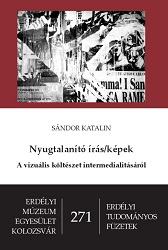Nyugtalanító írás/képek
Unsettling Image/Texts
On the Intermediality of Visual Poetry
Author(s): Katalin Sándor
Subject(s): Literary Texts, Fine Arts / Performing Arts, Poetry, Studies of Literature
ISSN: 2068-309X
Published by: Erdélyi Múzeum-Egyesület
Keywords: visual poetry
Summary/Abstract: In this volume I discuss the intermediality of visual poetry can correlate with the ideologies and projects of various movements but not as their unproblematic translation into the sphere of artistic practices. Consequently, I examine these movements as ideological constructs having their own (self)contradictions, revealing at times discrepancies between the declared projects and the concrete artistic results.In the volume I discuss three specific figures of visual poetry – concrete and lettrist poetry and collages – in three different chapters due to the fact that these figures can be related to different historical contexts and display different imagetext relations.Concrete poetry (e. g. poems by Gomringer, Heisenbüttel, de Campos, Kolár) can be perceived as an attempt to extend the limits of language, to reveal both the verbal and the non-verbal conditions of reading. In concretism language does not appear as purely conceptual but as an embodied language, whereas reading is not a medially homogeneous practice but is shaped by the iconicity of the text, by the sensuality of writing and the ”silent”, non-discursive spaces between words. From the perspective of image-text relations, figurative concrete poetry tends to display a shift from naming and convergence towards divergence by scattering the correspondence between word and image (which can be related to the modernist experience of losing the common system of reference between words and things). In non-figurative concrete poetry the shaping of the typographic space, the non-linear distribution of writing, the combination and variation of linguistic elements are meant to foreground not the referentiality but rather the materiality of language.In lettrist poetry and in typograms (e. g. the works of Isou, Broutin, Szombathy, Géczi, Tandori, L. Simon) the non-semantic use of writing as visual material seems to extract even the last verbal elements from the process of reading, apparently replacing the problem of medial heterogeneity with that of monomediality.Although lettrist poems minimize the linguistic elements and foreground the physical aspects of language, they do not exclude the verbal dimension altogether.Hypergraphics as a mode of writing suggested by lettrist authors, combines different sign-systems evoking in this way the cultural memory of writing: from pictograms to mathematical signs, from iconic signs to the latin alphabet, from drawing to calligraphy. Another argument in favour of intermediality could be that lettrist works are prepared, announced, justified by poetic manifests and theoretical discourses which actually function as discursive pre-texts for the works themselves. (Referring to abstract painting, W. J. T. Mitchell speaks about a similar problem, namely the interdependence of theory and painting, which he calls ut pictura theoria.)In the collages of visual poetry (e. g. the works of McCaffery, Géczi, Zalán, Szombathy) both texts and images appear as fragments from larger contexts: from literature and painting to science and mass-media, from the anonymous found objects to the cultic products of culture. In collages the use of words and images becomes a contextual practice, more precisely a confrontation of different contexts.We can observe the eruption of images in the sphere of verbality (and vice versa), which marks an important difference between the perception of language in collages and the concretist concept about a decontextualized language, purified of referentiality. This impurity and medial heterogeneity of collages can expose the ideology and the contradictory aspect of certain modernist tendencies to purify the medium of language or painting to get to its essence.The above-mentioned figures of visual poetry can become the antecedents of certain intermedial practices in the digital medium. I discuss the way digital texts become flexible or even unstable, offering the readers the possibility to alter or recreate images and texts. In some texts the iconic-calligrammatic aspect which is based on a static, compositional correspondence can be replaced by correspondences between different temporal processes and performative acts. Those texts and multimedial installations which involve the human body in the process of reception expose the act of reading and communication as an embodied and not entirely discursive practice.The study of intermediality has made clear that the relation between texts and images is not relevant only from the perspective of mediality. More precisely: neither the problem of mediality can be restricted to technical and material aspects, but extends to the symbolic practices, the ideological and institutional contexts of the medium. Thus, collages do not only combine texts and images but also display a reflexive (or at times critical) attitude towards tradition and different cullural phenomena by confronting canonical and marginal, artistic and non-artistic discourses.In concrete poetry not only the image-text relation is raised as a problem but also the discursive and medial conditions of seeing and meaning-making.Although from the perspective of cultural criticism some works of visual poetry are considered a ’weak’ self-referential discourse, I would still emphasize the critical potential of reflecting on the medium and intermediality. Ideological constructs can be questioned precisely by revealing their constructedness, as well as their institutional, discursive and medial conditions. Intermediality as a critical practice and the capacity of intermedial phenomena to displace homogeneous discourses and institutional or disciplinary practices can show us that intermediality is not only the name of a (stable) relation between words and images but a continuous question and challenge.
- Print-ISBN-13: 978-606-8178-40-0
- Page Count: 198
- Publication Year: 2011
- Language: Hungarian
- Table of Content
- Introduction
- eBook-PDF

